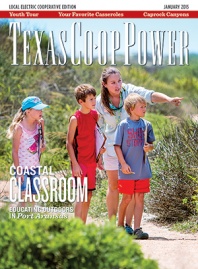A Family Heirloom Madstone
I enjoyed the article about madstones [“Deer Camp Folk Medicine,” November 2014]. I have a madstone that was passed to me by my mother. A friend gave it to her in 1963. He told her the treasured madstone had been in his family since the mid-1800s. It is shaped like an egg, has a tan background color with small, round black spots all over it. On one side, it appears like someone scraped off part of the outside layer to reveal a porous part of the stone. The stone is about 2 inches long and 1¼ inches wide. Thanks to Gene Fowler for the great story.
Marsha Greer | Tyler
Cherokee County EC
Tell Us Another One
I always read my issue of Texas Co-op Power cover to cover and enjoyed the short note in Energy News [“Gnaw News is Good News,” November 2014]. It reminded me of my father, who was a mailman in downtown San Antonio from 1928 through 1960. As he rose in seniority, he got some choice routes in downtown San Antonio, including the top half of the Milam Building, the first air-conditioned high-rise in America, housing the offices of many wealthy Texas oilmen. Before that, he had the route near the downtown main Post Office, including the Alamo. Just about anything anybody mentioned would elicit the statement, “That reminds me of a joke.”
One was, “The man that can come up with a dog-food formula that tastes like a postman’s leg will make a million dollars.” When he told this joke on television one day, my mother heaved a sigh of relief. “I didn’t know he knew any clean jokes,” she said.
Thanks for the memory.
Charles Postlewate | Granbury
United Cooperative Services
Did It Sign the Declaration?
I enjoyed your article about famous trees of Texas [“Tall Tales,” October 2014] and have another tale to add. La Bahia Pecan tree on the Washington-on-the-Brazos Historic Site overlooks the ferry crossing where the Navasota and Brazos rivers meet. Tests by the Forest Service confirm that this tree stood in 1836 when delegates adopted the Texas Declaration of Independence and also revealed that its nearest relatives are in Mexico.
That means that the tree’s pecans traveled along La Bahia Road as the settlement of Texas spurred traffic through Texas. Seedlings propagated from this historic tree are now available, thanks to Ellison’s Greenhouses, the USDA, the Texas A&M Forest Service, Bluebonnet Electric Cooperative and others. The nuts for the seedlings were picked from the tree using a bucket truck from Bluebonnet Electric.
Jim Kolkhorst | Washington-on-the-Brazos
Bluebonnet EC
The Panna Maria Oak?
Such a wonderful article [“Tall Tales,” October 2014]. I was born and raised in San Antonio, and those cypress trees on the River Walk are fond memories of my growing up there.
There is a very important oak tree in southeast Texas that should be mentioned. A group of Polish immigrants landed on the coast of Texas in 1854. They headed west and eventually stopped under this giant oak tree on Christmas Eve and celebrated Mass. Thus was born the oldest Polish settlement in the United States: Panna Maria, Texas.
My great-great-grandparents were part of that group. The oak tree and the church they built are still there. My husband and I were married there in 1981. Also, in Highland Village, where I now live, are two of the largest pecan trees recorded in all of North Texas. They are beautiful; hopefully they will continue on with their long lives for many years to come.
Virginia Murphy | Highland Village
CoServ Electric
Photographic Proof
Enjoyed the Anderson Mill article (that appeared in the Pedernales EC edition of the magazine). We lived about a mile from the mill and had friends who were members. I was given a photograph taken by Studers in San Antonio. I think it might be an earlier photo, and it definitely was taken from a different angle. Also have a postcard with your photo.
Thanks for the article.
D.J. Babyak | Granite Shoals
Pedernales EC


